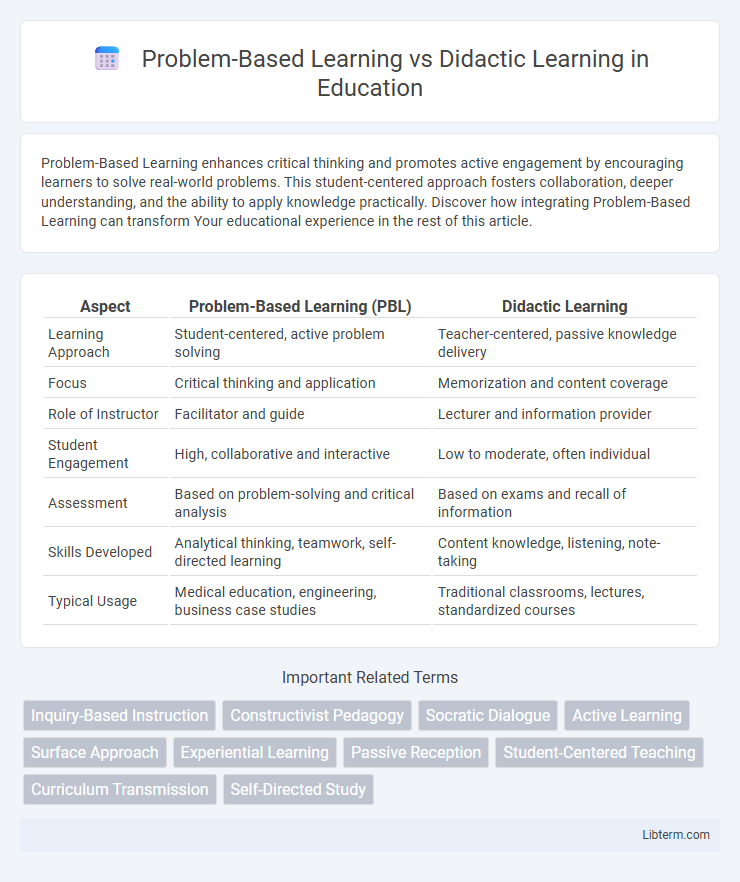Problem-Based Learning enhances critical thinking and promotes active engagement by encouraging learners to solve real-world problems. This student-centered approach fosters collaboration, deeper understanding, and the ability to apply knowledge practically. Discover how integrating Problem-Based Learning can transform Your educational experience in the rest of this article.
Table of Comparison
| Aspect | Problem-Based Learning (PBL) | Didactic Learning |
|---|---|---|
| Learning Approach | Student-centered, active problem solving | Teacher-centered, passive knowledge delivery |
| Focus | Critical thinking and application | Memorization and content coverage |
| Role of Instructor | Facilitator and guide | Lecturer and information provider |
| Student Engagement | High, collaborative and interactive | Low to moderate, often individual |
| Assessment | Based on problem-solving and critical analysis | Based on exams and recall of information |
| Skills Developed | Analytical thinking, teamwork, self-directed learning | Content knowledge, listening, note-taking |
| Typical Usage | Medical education, engineering, business case studies | Traditional classrooms, lectures, standardized courses |
Introduction to Problem-Based Learning and Didactic Learning
Problem-Based Learning (PBL) emphasizes active student engagement through real-world problem solving, fostering critical thinking and collaborative skills. Didactic Learning relies on instructor-led lectures and structured content delivery, prioritizing information memorization and standardized assessments. The introduction to PBL highlights learner-centered approaches, whereas Didactic Learning focuses on teacher-centered knowledge transmission.
Core Principles of Problem-Based Learning
Problem-Based Learning (PBL) centers on student-driven inquiry, collaborative teamwork, and real-world problem-solving to foster critical thinking and knowledge application. Unlike Didactic Learning, which emphasizes instructor-led content delivery and passive absorption, PBL engages learners actively in identifying learning needs and integrating interdisciplinary concepts. Core principles include self-directed learning, contextual relevance, iterative reflection, and facilitation by instructors as guides rather than lecturers.
Key Features of Didactic Learning
Didactic learning emphasizes structured, teacher-centered instruction where information is delivered systematically through lectures and textbooks. It prioritizes content mastery with a clear curriculum, standardized assessments, and a focus on memorization and repetition. This method ensures consistent knowledge transfer but may limit critical thinking and problem-solving opportunities typically encouraged in problem-based learning.
Differences in Teaching Approaches
Problem-Based Learning centers on student-driven inquiry and collaboration to solve real-world problems, promoting critical thinking and active engagement. Didactic Learning relies on teacher-led instruction, delivering structured content through lectures and memorization, emphasizing knowledge transmission. The former fosters autonomous learning skills, while the latter ensures efficient coverage of specific curriculum objectives.
Impact on Student Engagement
Problem-Based Learning (PBL) significantly enhances student engagement by promoting active participation, critical thinking, and real-world problem-solving skills. Didactic learning often leads to passive information absorption, resulting in lower motivation and reduced cognitive involvement. Research shows that students in PBL environments demonstrate higher retention rates and increased intrinsic motivation compared to those in traditional lecture-based settings.
Assessment Methods Compared
Assessment methods in Problem-Based Learning (PBL) emphasize formative evaluation through real-world problem-solving tasks, reflective journals, and peer assessments, promoting critical thinking and application of knowledge. Didactic learning assessments typically rely on summative evaluations such as standardized tests, quizzes, and written exams, focusing on memorization and recall of factual information. PBL assessment fosters deeper understanding by integrating continuous feedback, while didactic methods prioritize retention of discrete knowledge units.
Skill Development Outcomes
Problem-Based Learning (PBL) significantly enhances critical thinking, collaboration, and problem-solving skills by engaging students in real-world scenarios, fostering deeper understanding and practical application of knowledge. Didactic Learning primarily focuses on the transmission of factual information through lectures, often resulting in higher content retention but limited development of adaptive skills and creativity. Studies indicate that PBL graduates demonstrate superior ability in teamwork and self-directed learning, crucial competencies in dynamic professional environments.
Application in Various Educational Settings
Problem-Based Learning (PBL) enhances critical thinking and real-world problem-solving skills by engaging students in collaborative inquiry across disciplines such as medicine, engineering, and social sciences. Didactic Learning emphasizes structured content delivery through lectures and textbooks, proving effective for foundational knowledge in large classroom settings and standardized curricula. Educational institutions often combine both approaches to balance theoretical understanding with practical application, optimizing learner outcomes in diverse academic environments.
Advantages and Challenges of Each Method
Problem-Based Learning (PBL) enhances critical thinking, promotes collaboration, and fosters deep understanding by engaging students in real-world problem-solving scenarios, although it may require more time and resources to implement effectively. Didactic Learning offers structured, efficient knowledge delivery and is easier to scale in large classrooms, but it often limits student interaction and critical thinking development. Balancing PBL and didactic approaches can maximize educational outcomes by leveraging the strengths and mitigating the challenges of each method.
Choosing the Right Learning Approach
Choosing the right learning approach depends on educational goals, student needs, and content complexity. Problem-Based Learning (PBL) fosters critical thinking, collaboration, and real-world application, making it ideal for developing problem-solving skills. Didactic Learning emphasizes structured knowledge delivery and foundational concepts, suitable for efficient instruction of core information and theory.
Problem-Based Learning Infographic

 libterm.com
libterm.com